| Junipers | |
|---|---|
 | |
| Genus: | Juniperus |
| Family: | Cupressaceae |
| Type: | Trees, Shrubs |
| Pollination: | Wind |
Junipers are coniferous evergreen trees and shrubs, belonging in the cypress family (Cupressaceae). Depending on taxonomic viewpoint, there are between 50-67 species of juniper, widely distributed throughout the northern hemisphere, from the Arctic, south to tropical Africa in the Old World, and to the mountains of Central America in the New World.
There are many species to choose from in the landscape, most of which are tough, and very drought tolerant. Some species are widely used as ground covers, others for hedging, but primarily they are used as evergreen "anchoring" plants in mixed borders and foundation plantings.
Description
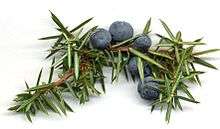
Junipers vary in size and shape from tall trees, 20–40 m tall, to columnar or low spreading shrubs with long trailing branches. They are evergreen with either needle-like and/or scale-like leaves. They can be either monoecious or dioecious. The female seed cones are very distinctive, with fleshy, fruit-like coalescing scales which fuse together to form a "berry"-like structure, 4–27 mm long, with 1-12 unwinged, hard-shelled seeds. In some species these "berries" are red-brown or orange but in most they are blue; they are often aromatic (for their use as a spice, see juniper berry). The seed maturation time varies between species from 6–18 months after pollination. The male cones yellow and catkin-like, with 6-20 scales; most shed their pollen in early spring, but some species pollinate in the autumn.
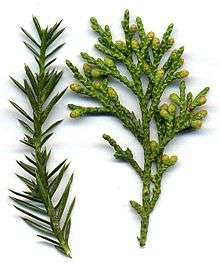
Many junipers (e.g. J. chinensis, J. virginiana) have two types of leaves: seedlings and some twigs of older trees have needle-like leaves 5–25 mm long; and the leaves on mature plants are (mostly) tiny (2–4 mm long), overlapping and scale-like. When juvenile foliage occurs on mature plants, it is most often found on shaded shoots, with adult foliage in full sunlight. Leaves on fast-growing 'whip' shoots are often intermediate between juvenile and adult.
In some species (e.g. J. communis, J. squamata), all the foliage is of the juvenile needle-like type, with no scale leaves. In some of these (e.g. J. communis), the needles are jointed at the base, in others (e.g. J. squamata), the needles merge smoothly with the stem, not jointed.
The needle-leaves of junipers are hard and sharp, making the juvenile foliage very prickly to handle. This can be a valuable identification feature in seedlings, as the otherwise very similar juvenile foliage of cypresses (Cupressus, Chamaecyparis) and other related genera is soft and not prickly.
Growing conditions
Most species prefer a well-drained soil (though at least one (J. virginiana) will grow in wet soils as well), and full sun to very light shade.
Species
The number of juniper species is disputed, with two recent studies giving very different totals, Farjon (2001) accepting 52 species, and Adams (2004) accepting 67 species. The junipers are divided into several sections, though (particularly among the scale-leaved species) which species belong to which sections is still far from clear, with research still on-going. The section Juniperus an obvious monophyletic group though.
- Juniperus sect. Juniperus: Needle-leaf junipers. The adult leaves are needle-like, in whorls of three, and jointed at the base (see below right).
- Juniperus sect. Juniperus subsect. Juniperus: Cones with 3 separate seeds; needles with one stomatal band.
- Juniperus communis - Common Juniper
- Juniperus communis subsp. alpina - Alpine Juniper
- Juniperus conferta - Shore Juniper (syn. J. rigida var. conferta)
- Juniperus rigida - Temple Juniper or Needle Juniper
- Juniperus communis - Common Juniper
- Juniperus sect. Juniperus subsect. Oxycedrus: Cones with 3 separate seeds; needles with two stomatal bands.
- Juniperus brevifolia - Azores Juniper
- Juniperus cedrus - Canary Islands Juniper
- Juniperus deltoides - Eastern Prickly Juniper
- Juniperus formosana - Chinese Prickly Juniper
- Juniperus lutchuensis - Ryukyu Juniper
- Juniperus navicularis - Portuguese Prickly Juniper
- Juniperus oxycedrus - Western Prickly Juniper or Cade Juniper
- Juniperus macrocarpa (J. oxycedrus subsp. macrocarpa) - Large-berry Juniper
- Juniperus sect. Juniperus subsect. Caryocedrus: Cones with 3 seeds fused together; needles with two stomatal bands.
- Juniperus drupacea - Syrian Juniper
- Juniperus sect. Juniperus subsect. Juniperus: Cones with 3 separate seeds; needles with one stomatal band.
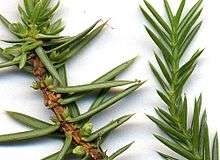
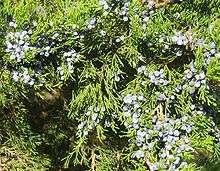
- Juniperus sect. Sabina: Scale-leaf junipers. The adult leaves are mostly scale-like, similar to those of Cupressus species, in opposite pairs or whorls of three, and the juvenile needle-like leaves are not jointed at the base (including in the few that have only needle-like leaves; see below right). Provisionally, all the other junipers are included here, though they form a paraphyletic group.
- Old World species
- Juniperus chinensis - Chinese Juniper
- Juniperus chinensis var. sargentii - Sargent's Juniper
- Juniperus convallium - Mekong Juniper
- Juniperus excelsa - Greek Juniper
- Juniperus excelsa subsp. polycarpos - Persian Juniper
- Juniperus foetidissima - Stinking Juniper
- Juniperus indica - Black Juniper
- Juniperus komarovii - Komarov's Juniper
- Juniperus phoenicea - Phoenicean Juniper
- Juniperus procera - East African Juniper
- Juniperus procumbens - Ibuki Juniper
- Juniperus pseudosabina - Xinjiang Juniper
- Juniperus recurva - Himalayan Juniper
- Juniperus recurva var. coxii - Cox's Juniper
- Juniperus sabina - Savin Juniper
- Juniperus sabina var. davurica - Daurian Juniper
- Juniperus saltuaria - Sichuan Juniper
- Juniperus semiglobosa - Russian Juniper
- Juniperus squamata - Flaky Juniper
- Juniperus thurifera - Spanish Juniper
- Juniperus tibetica - Tibetan Juniper
- Juniperus wallichiana - Himalayan Black Juniper
- Juniperus chinensis - Chinese Juniper
- New World species
- Juniperus angosturana - Mexican One-seed Juniper
- Juniperus ashei - Ashe Juniper
- Juniperus barbadensis - West Indies Juniper
- Juniperus bermudiana - Bermuda Juniper
- Juniperus blancoi - Blanco's Juniper
- Juniperus californica - California Juniper
- Juniperus coahuilensis - Coahuila Juniper
- Juniperus comitana - Comitán Juniper
- Juniperus deppeana - Alligator Juniper
- Juniperus durangensis - Durango Juniper
- Juniperus flaccida - Mexican Weeping Juniper
- Juniperus gamboana - Gamboa Juniper
- Juniperus horizontalis - Creeping Juniper
- Juniperus jaliscana - Jalisco Juniper
- Juniperus monosperma - One-seed Juniper
- Juniperus monticola - Mountain Juniper
- Juniperus occidentalis - Western Juniper
- Juniperus occidentalis subsp. australis - Sierra Juniper
- Juniperus osteosperma - Utah Juniper
- Juniperus pinchotii - Pinchot Juniper
- Juniperus saltillensis - Saltillo Juniper
- Juniperus scopulorum - Rocky Mountain Juniper
- Juniperus standleyi - Standley's Juniper
- Juniperus virginiana - Eastern Juniper
- Juniperus virginiana subsp. silicicola - Southern Juniper
- Old World species
Uses
Many of the earliest prehistoric people lived in or near juniper forests which furnished them food, fuel, and wood for shelter or utensils. Many species, such as J. chinensis (Chinese Juniper) from eastern Asia, are extensively used in landscaping and horticulture, and as one of the most popular species for bonsai. It is also a symbol of longevity.
Juniper berries are used in the distillation of gin and Jenever and the brewing of sahti. Juniper was also occasionally used in gruit, a mix of herbs used for flavouring beer prior to the use of hops.
The berries and needles are slightly poisonous and can cause irritation after ingestion or contact with the skin.
Maintenance
Persistent deadwood, rusts, and phomopsis blights can be troublesome for some species. Pruning is best done in winter or otherwise cool weather, as the sharp leaves and resin can cause an itchy rash if they brush exposed skin.
Propagation
Usually propagated by cuttings or grafting.
Harvest
Berries are harvested fresh.
Pests and diseases
- Phomopsos juniperovora
- Kabatina juniperi
- Seridium cardinale
- Gymnosporangium juniperae-virginianae (Cedar-Apple Rust)
- Gymnosporangium globosum
- Gymnosporangium clarariaeformae
Root Rots
- Phytophthora cinnamomi
Diebacks
Heart Rots
Wood Rots
Lesion Nematodes
- Rocky Mountain Juniper Aphid: Cinara sabinae (North America)
- Balsam Twig Aphid: Minardus abietinus (North America)
Scales
- Juniper Scale: Carulaspis juniperi (North America)
- Greedy Scale: Hemiberlesia rapax (North America)
- Fletcher Scale: Parthenolecanium fletcheri (North America)
- Minute Cypress Scale: Carulaspis minima (North America)
Spittlebugs
- Juniper Spittlebug: Clastoptera juniperiana (North America)
- Juniper Mealybug: Pseudococcus juniperi (North America)
Flies
- Juniper Midge: Contarinia juniperina (North America)
- Juniper Tip Midge: Oligotrophus betheli (North America)
- Redcedar Bark Beetle: Phloeosinus dentatus (North America)
- Arborvitae Weevil: Phyllobius intruscus (North America)
- Juniper Carpet: Thera juniperata (Europe)
- Bucculatrix inusitata (Europe, on J. communis)
- Cypress Tip Miner: Argyresthis cupressella (North America)
- Leafminer: Coleotechnites juniperella (North America)
- Juniper Webworm: Dichomeris marginella (North America)
- Bagworm: Thyridopterix ephemeraeformis (North America)
- Silverspotted Tiger Moth: Lophocampa argentata (North America)
- Juniper Twig Girdler: Periploca nigra (North America)
- Juniper Pug: Eupithecia pusillata (Europe, North America, Near East)
- Pine Beauty: Panolis flammea (Europe)
- Chionodes electella
- Chionodes viduella
- Juniper Sawfly: Monoctenus fulvus (North America)
- Arborvitae Sawfly: Monoctenus melliceps (North America)
- Spruce Spider Mite: Oligonychus ununguis (North America)
- Mite: Platytetranychus libocedri (North America)
- Twospotted Spider Mite: Tetranychus urticae (North America)
- Budgall Mite: Trisecatus juniperinus (North America)
- Juniper Berry Mite: Trisecatus quadrisetus (North America)
Winter Damage:
- Ice coatings may suffocate branchlets.
- Prone to brakage under wet, heavy snowloads.
Gallery
 Juniperus bermudiana
Juniperus bermudiana Juniperus californica
Juniperus californica Juniperus chinensis
Juniperus chinensis Juniperus communis
Juniperus communis Juniperus conferta
Juniperus conferta Juniperus deppeana
Juniperus deppeana Juniperus excelsa
Juniperus excelsa Juniperus horizontalis
Juniperus horizontalis Juniperus occidentalis
Juniperus occidentalis Juniperus oxycedrus
Juniperus oxycedrus- Juniperus phoenicea
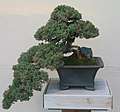 Juniperus procumbens
Juniperus procumbens Juniperus recurva
Juniperus recurva Juniperus rigida
Juniperus rigida Juniperus sabina
Juniperus sabina Juniperus scopulorum
Juniperus scopulorum Juniperus squamata
Juniperus squamata Juniperus thurifera
Juniperus thurifera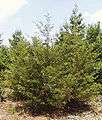 Juniperus virginiana
Juniperus virginiana
References
- Adams, R. P. (2004). Junipers of the World: The genus Juniperus. Trafford. ISBN 1-4120-4250-X
- Farjon, A. (2001). World Checklist and Bibliography of Conifers. Kew. ISBN 1-84246-025-0
- Farjon, A. (2005). Monograph of Cupressaceae and Sciadopitys. Royal Botanic Gardens, Kew. ISBN 1-84246-068-4
- Junipers of the world
- Gymnosperm Database - Juniperus
- Arboretum de Villardebelle Photos of cones and foliage of selected species
- Ann Fowler Rhoads and Timothy A. Block (2000). The Plants of Pennsylvania: An Illustrated Manual. Anna Anisko, illustrator. Morris Arboretum, University of Pennsylvania Press. pp. 108.
- Christopher Brickell and Judith D. Zuk (1997). The American Horticultural Society A-Z Encyclopedia of Garden Plants. DK Publishing. pp. 573–576.
- Staff of the L. H. Bailey Hortorium (1976). Hortus Third: A Concise Dictionary of Plants Cultivated in the United States and Canada. Cornell University Press. pp. 615–617.
- Pirone, Pascal P. (1978). Diseases & Pests of Ornamental Plants (Fifth Edition ed.). John Wiley & Sons, New York. pp. 324–327.
- Cranshaw, Whitney (2004). Garden Insects of North America: The Ultimate Guide to Backyard Bugs. Princeton University Press. pp. 601.
- Pippa Greenwood, Andrew Halstead, A.R. Chase, Daniel Gilrein (2000). American Horticultural Society Pests & Diseases: The Complete Guide to Preventing, Identifying, and Treating Plant Problems (First Edition ed.). Dorling Kindersley (DK) Publishing, inc.. pp. 196.